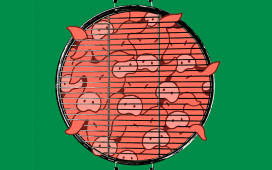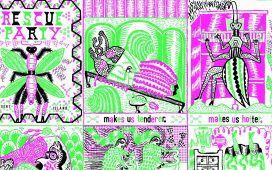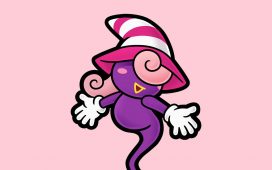One of the seismic cultural shifts of the pandemic era has been a migration into fantasies. Some of them are troubling, such as the conspiratorial prejudice that has fuelled QAnon and the recent surge in violence against those of Asian descent. Others are restorative: the immersive worlds of books, the virtual realities of video games, the hypnotic lull of binge-streamed television series.
Many of the escapes that we use to nourish ourselves originated in Japan. The stunning success of Nintendo’s Animal Crossing: New Horizons, which sold thirty-one million copies worldwide last year, is a striking example. Now we have another, in the form of an imported anime with a mouthful of a title: “Demon Slayer: Kimetsu no Yaiba the Movie: Mugen Train.” It débuted in Japanese theatres in October of 2020, then arrived in American ones in April. It quickly set records for the highest-grossing opening weekend for a foreign film, as well as the highest-earning R-rated animated film. All of this has conspired to make it the planet’s single top-grossing film of 2020.
This success might seem surprising, as anime has long been considered a fringe subculture, but the film’s momentum was presaged by the enthusiasm of its reception in Japan. When “Mugen Train” opened there, pandemic-weary audiences flocked to see it in theatres outfitted with socially distanced seating. By the end of the year, the film had emerged as more than simply a coronavirus phenomenon. It had done the unthinkable, unseating Hayao Miyazaki’s 2001 epic, “Spirited Away,” to become the highest-grossing film in Japanese history. What Miyazaki’s beloved film had earned over the course of nineteen years, “Mugen Train” surpassed in just three months.
It’s tempting to frame the success of “Mugen Train” as a passing of the torch from an elderly master to a younger generation—and, indeed, Miyazaki has said that he considers the film a “rival.” (Miyazaki, who has announced his retirement numerous times over the decades, is currently working on what is purported to be his final film, titled “How Do You Live?”) But “Mugen Train” is the product of a very different creative process, and a very different media environment. Miyazaki’s films are meditative, self-contained stories, created and financed independently, outside of the traditional corporate production committees that sustain Japan’s commercial animation industry. He is an auteur who wears his politics on his sleeve, pens his own scripts, insists on checking nearly every frame himself, and long resisted merchandising his creations. In contrast, the hyperkinetic “Mugen Train” is the latest installment in a series envisioned as a mass-market multimedia product from the very start. Tellingly, the vast majority of media coverage has focussed on its box-office success instead of its director, Haruo Sotozaki, or its writers, who aren’t credited individually but under the name of the film’s production company, Ufotable.
“Demon Slayer: Kimetsu no Yaiba the Movie: Mugen Train” is the continuation of a hit television series called “Demon Slayer: Kimetsu no Yaiba,” which was, in turn, based upon a hit manga of the same title, by the artist Koyoharu Gotoge. The series is set in Japan’s Taisho era, which lasted from 1912 to 1926; the precise date is never specified. The hero is Tanjiro Kamado, a boy who ekes out a living with his mother and siblings in the verdant mountains of a rapidly modernizing Japan. One day, Tanjiro returns from an errand to discover that his family has been slaughtered by demons: vicious monsters that roam the land in search of human blood. For these malevolent creatures, humans are both sustenance and a medium of reproduction, for once bitten, a human will inevitably turn demon. A blend of Western vampire lore and local Japanese folk traditions, the demons are dark mirrors of the human condition, their appearances varying wildly depending on whatever negative traits they possessed as humans. The lone survivor of this massacre is Tanjiro’s sister Nezuko, who now teeters on the cusp of turning into a demon herself. Before Tanjiro can react, a mysterious warrior appears and tries to kill Nezuko; Tanjiro instinctively protects her. During the battle, it becomes clear that Nezuko has retained her human personality and is actively resisting her thirst for blood. The stranger fits Nezuko with a bamboo gag—better safe than sorry—then instructs Tanjiro to seek out a secret society called the Demon Slayer Corps. So it is that the siblings are thrust into a shadow war playing out between humanity and demon-kind.
None of this context is explained in the film; instead, the backstory plays out across twenty-six blood-drenched television episodes, more than ten hours in total, available to stream on Netflix, Crunchyroll, and other platforms. “Demon Slayer: Kimetsu no Yaiba the Movie: Mugen Train” picks up precisely where the series leaves off. There is no recap, and nothing in the way of exposition. Theatregoers are presumed to have their tickets, so to speak, for the train ride on which most of the film’s action unfolds. (“It’s almost impressive how fast ‘Mugen Train’ is able to completely disorient anyone who doesn’t already know where it’s going,” IndieWire wrote.)
Expecting such familiarity with a large amount of source material would seem an obstacle to mainstream success, but “Mugen Train” had some help. Trapped indoors by COVID-19 restrictions, a lot of us turned to streaming platforms for solace, and a great many of the shows that we watched were anime. Netflix reported a fifty-per-cent increase in viewership of the genre compared to the year before.
“Demon Slayer: Kimetsu no Yaiba” débuted as a print manga, in February, 2016, in the pages of a magazine called Weekly Shonen Jump. Launched in 1968, Jump is one of Japan’s oldest and most successful manga weeklies; at its peak, in the nineties, it sold more than six million copies every week. Key to the publication’s enduring popularity is a calculated approach to cultivating talent, honed over the decades by an editorial department that carefully directs the output of freelance comic creators. Every issue of Jump contains a postcard asking readers to rank their favorite titles; this data is then used to shape the direction of story lines in real time. The Jump formula has produced some of Japan’s most enduring pop-cultural hits, including “Dragon Ball,” “Naruto,” “One Piece,” and “My Hero Academia.” It could be argued that, by teasing out episodes of manga via the “algorithm” of reader feedback, and then compiling the most popular series into separately sold stand-alone volumes that could be “binged” all at once, Jump presaged the way the world consumes streaming entertainment today.








